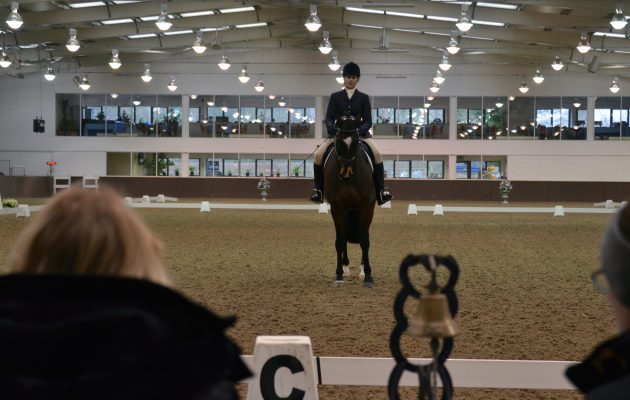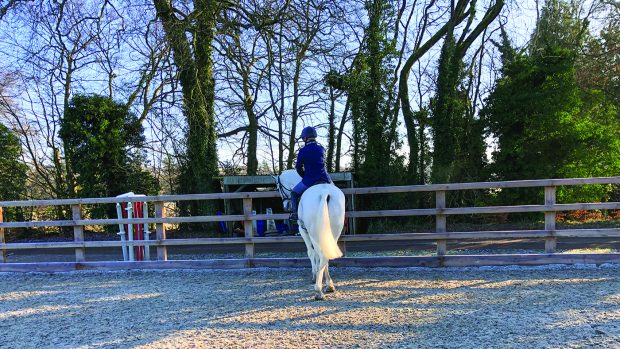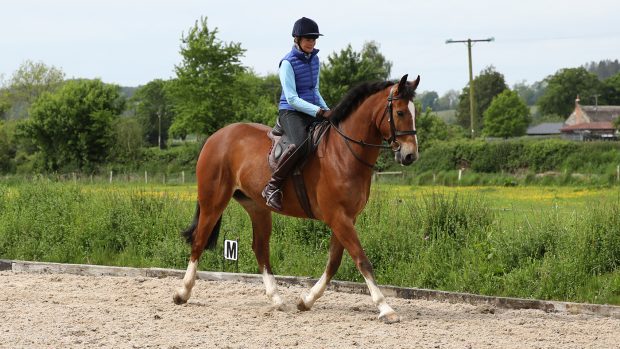Dressage trainer and author of Master Dressage Peter Dove shares some pearls of wisdom on common mistakes made by riders in dressage tests as well as how to prevent them and earn more marks
1. 20m circles
Peter says: “Riders need to be accurate at all times, both while competing and schooling at home. When riding 20m circles, I see a lot of what I call ‘squircles’ where the shape is completely wrong. Competitors will either go into the corners and then make a flat shape at the apex of the circle where the horse tends to end up on its outside shoulder or they will follow the track too far around the arena and then turn to make the top of the circle which means it ends up square.
“In order to ride a correct 20m circle, imagine the shape you need to ride is a balance beam which has just enough room for your horse to go along the top of it. Then think to yourself about which side of the balance beam your horse would fall off, and make the correction. If it is a left-handed circle, your horse should always be making steps to the left. Imagine a circle inside a square — the circle will only touch four points of the square — as soon as your horse touches each point, it must immediately leave it. For example, if your circle starts at A, your horse should step off the track as soon as it reaches the marker.
“You shouldn’t be anywhere near the corners of the arena — after starting your circle from A, you should be aiming for the next point on the track 10m from the corner (or 4m beyond the corner marker letter). Don’t let your horse continue wandering through its outside shoulder once you reach the apex of the circle. Finally, once you return to the starting point of the circle, straighten your horse up onto the track.”
2. Change the rein across the diagonal
Peter says: “The most common mistake riders make when performing this movement is that they come out of the starting corner too quickly. You need to bear in mind that you have 6m out of the corner to ride before you reach the marker from which the movement actually starts. Therefore, ride into the corner, with your horse’s legs stepping away from the track smoothly at the marker.
“Don’t aim your horse’s nose at the marker at the end of the diagonal — your horse is long, so by the time its body has all got onto the track, you will find yourself already in the corner. So instead, as you ride across the diagonal, aim your horse’s nose half a horse’s length before the marker, so that you help prevent falling through the corner.”
3. Corners
Peter says: “I advise riders not to think about riding into the corners as they think they should. Instead think of corners as ¼ circles. Start the turn 5m from the corner and ride a smooth curve so that you maintain balance and rhythm.”
4. Centre lines
Peter says: “Never turn onto the centre line when you get to the marker — your horse can’t do 90 degree turns! Instead, like corners, think of the turn as being a ¼ circle. Start your turn before the marker — how far this is is dependent on your horse, like his size and experience. Look for the end marker you are heading for so that you are focused and can make any necessary small adjustments to keep your horse on the centre line. Don’t turn your shoulders as you will lose the balance and outside shoulder of your horse — it’s much better if you keep your shoulders square over your hips and just turn your head.”
5. Give and retake the reins
Peter says: “Riders need to stay upright in their bodies when they give the reins away — don’t collapse forward. Horses need to maintain their own self-carriage without the support of the rider, so it is therefore the rider’s job to show a clear loop in the rein, with their hands pushed forwards towards the bit in order to get the best marks. The judge won’t mind if the horse takes its head and neck forwards slightly, as long as they don’t fall onto the forehand.”
You may also be interested in…

Improve your dressage scores: how and why to ride a give and retake of the reins

‘Watch riders that you admire’ — plus 6 more top tips from dressage riders

Subscribe to Horse & Hound magazine today – and enjoy unlimited website access all year round
Horse & Hound magazine, out every Thursday, is packed with all the latest news and reports, as well as interviews, specials, nostalgia, vet and training advice. Find how you can enjoy the magazine delivered to your door every week, plus options to upgrade your subscription to access our online service that brings you breaking news and reports as well as other benefits.




